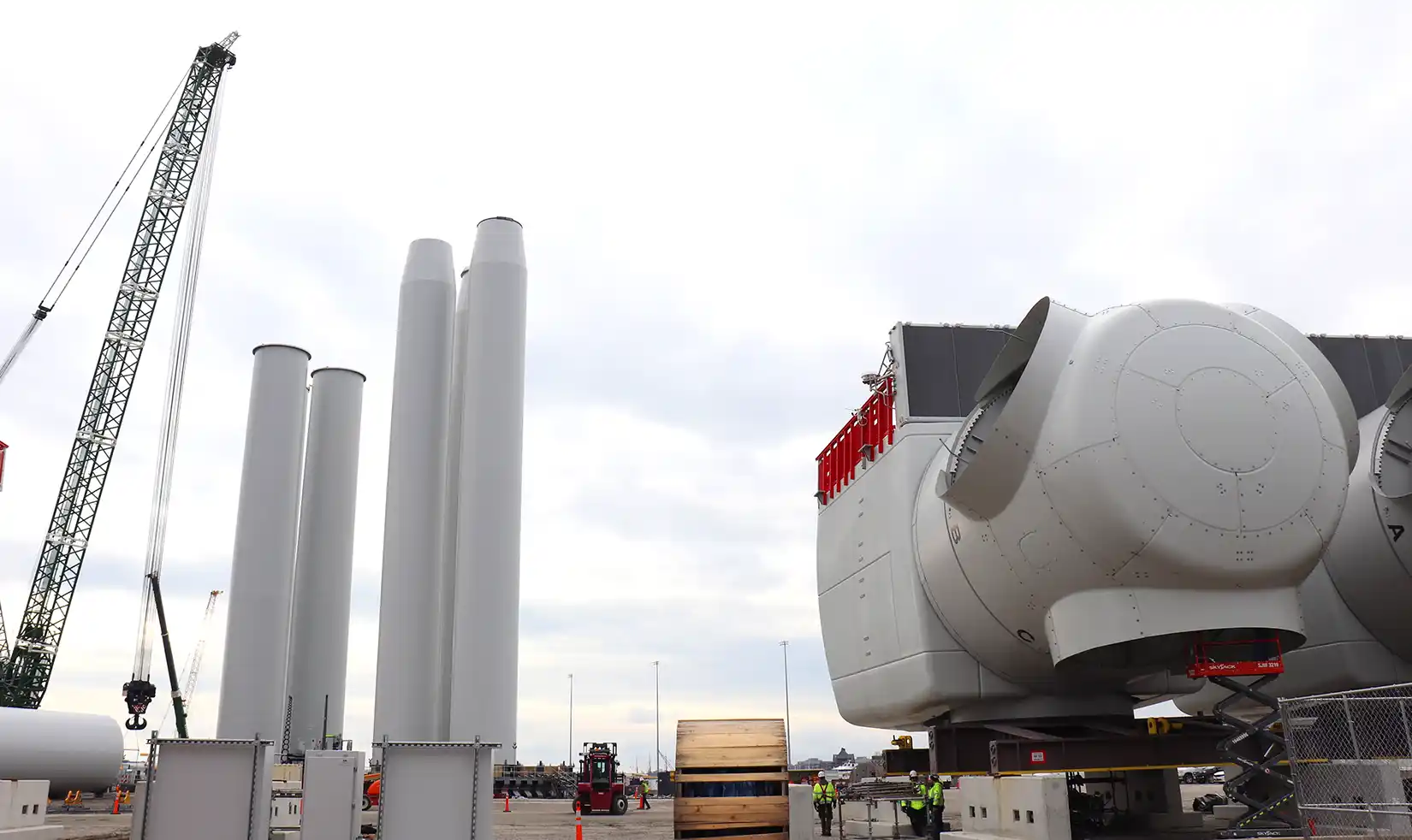West Coast Ports Strategy Study
NLR identifies opportunity for a strategically designed ports network that can unlock the potential of commercial-scale wind energy deployment off the U.S. West Coast.

The U.S. West Coast is ramping up energy production, with states considering the potential to add commercial-scale floating offshore wind power to their energy sources, which is also possible along other American coastlines.
Unfortunately, without needed upgrades, a lack of suitable port infrastructure could make it difficult to build major wind energy technology components domestically and install projects efficiently. This limitation could prevent the offshore wind energy industry from contributing to the U.S. energy mix and growth.
The industry has the opportunity to strategically develop a collaborative port network that could efficiently, cost effectively, and reliably support fabrication, installation, and operation and maintenance activities along the U.S. West Coast.
With funding from the U.S. Department of Energy's Wind Energy Technologies Office, NLR led the collaborative effort to develop a West Coast ports strategy.
What the United States Needs
Ports
The United States would need to develop three primary types of port sites on the West Coast to enable commercial-scale floating offshore wind energy deployment. They are:
- Manufacturing/fabrication sites, where major components are built, stored,
and transported
- Staging and integration sites, where components are delivered, stored, and assembled
into complete systems that can be towed to the project site
- Operation and maintenance sites, which act as a base for vessels that perform regular maintenance activities.
The number of available port sites can dictate the amount of offshore wind energy that can be deployed. Meeting California’s 25-GW offshore wind energy target by 2045 would likely require four staging and integration sites and at least eight operations and maintenance sites within the state, which could cost around $5 billion to develop.
An ambitious offshore wind energy deployment scenario of 55 GW along the entire West Coast by 2045 could require nine staging and integration sites (at four or five ports) and 17 operations and maintenance sites along the coasts of California, Oregon, and Washington, with an associated investment of around $11 billion.
A Supply Chain
West Coast states could choose to develop a local supply chain, which could create local jobs and economic benefits, de-risk deployment by reducing dependencies on imports, and reduce emissions associated with transportation.
Expanding the port network to create a West Coast supply chain could require 16–28 additional sites to support 25–55 GW of deployment, respectively. These manufacturing sites would likely cost an additional $11 billion–$19 billion to construct.
A West Coast supply chain could eliminate the need for transporting major components across the Pacific Ocean.
| Port Location and Type | Target Deployment: 25 GW | Target Deployment: 35 GW | Target Deployment: 55 GW |
|---|---|---|---|
California Staging and Integration | 4 | 4 | 5 |
California Operations and Maintenance | 8 | 8 | 10 |
California Manufacturing and Fabrication (With U.S. Supply Chain) | 9 | 12 | 16 |
Washington and Oregon Staging and Integration | 0 | 2 | 4 |
Washington and Oregon Operations and Maintenance | 0 | 2 | 7 |
Washington and Oregon Manufacturing and Fabrication (With U.S. Supply Chain) | 7 | 9 | 12 |
Total Investment (in $ Billion; Without Supply Chain) | 4.4 | 6.5 | 11.1 |
Total Investment (in $ Billion; With U.S. Supply Chain) | 15.3 | 20.1 | 29.8 |
Total Offshore Wind Energy Deployed by 2045 (in Gigawatts) | 23.8 | 34 | 50.1 |
Potential Impacts of Developing Ports
Clearly, a port network would require a significant investment and take time (potentially 10 years or more to plan, permit, and construct). Although these are large investments, they could enable hundreds of billions of dollars' worth of floating offshore wind energy to be deployed on the West Coast.
NLR considered the impact of a developed port network and found that, on the West Coast:
- A supply chain could be cost-competitive because of reduced transportation costs and
tax incentives, although labor and raw material costs
may be cheaper for overseas manufacturing hubs
- A supply chain developed by collaboration among California, Oregon, and Washington
reduces the risk of global supply chain bottlenecks and creates local jobs and economic
benefits because, although all West Coast states have several suitable ports for different
aspects of development, no single state has enough sites
to conduct all of the manufacturing needed for even a 25-GW level of deployment
- Port development could offer port and coastal communities benefits such as job opportunities, though there should be consideration of socio-economic burdens
- The distance between the installation sites and operations ports could have significant impacts on the levelized cost of energy, which could increase by 15% if this distance increases from 50 to 400 km.
How To Develop a West Coast Ports Network
The significant investment needed to develop ports on the West Coast could enable even higher levels of offshore wind energy deployment; however, uncertainty around deployment levels, technology choices, and stakeholder considerations create challenges for port investment.
NLR's report outlines potential actions to address major challenges, including to:
- Improve communication and strategic planning between key stakeholders to establish long-term plans, best practices, and roles within the port network
- Conduct up-front coordination with all involved communities
- Develop new programs to train construction workers and port workers
- Achieve a transparent and predictable permitting process for new/upgraded ports
- Coordinate with operators and shipyards to help develop a fleet of vessels.
Publications
The Impacts of Developing a Port Network for Floating Offshore Wind Energy on the West Coast of the United States, NLR Technical Report (2023)
Contact
Share
Last Updated Dec. 6, 2025
